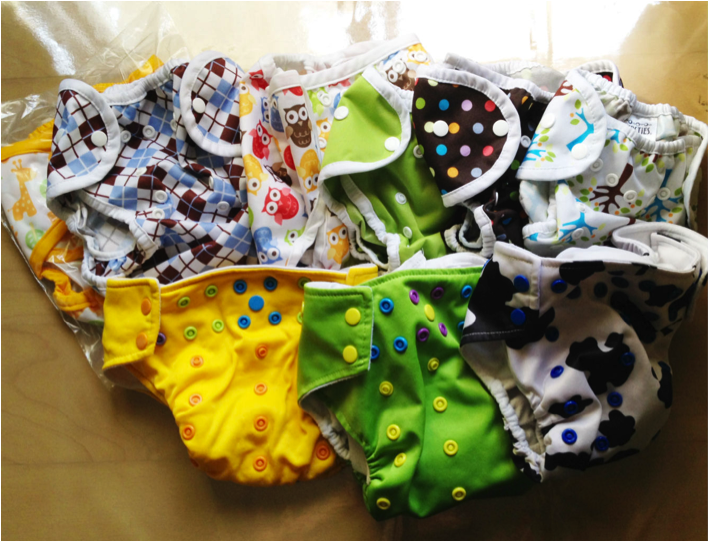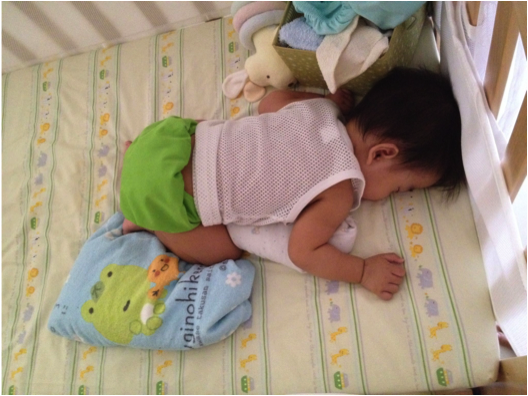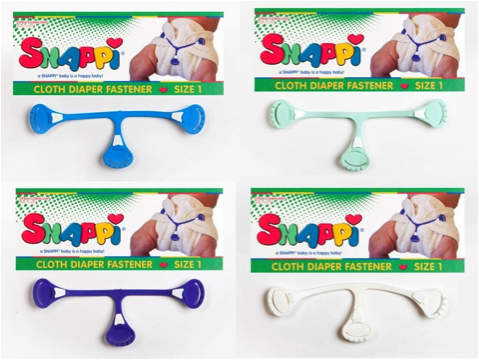By Ruth Song
Back in 2013, when I told people I was putting by then newborn son, Noah in cloth diapers, I had people feeling my forehead to see if I was crazy. “Don’t you already have enough to do?” they would ask me.
So what made me take the route less travelled, and go the cloth-diapering way?

The problem with disposable diapers
When I was pregnant, I began to wonder what kind of world I wanted to create for him and that forced me to re-look at how I wanted to use my resources, especially diapers since he would produce so much waste from it.
The thing about disposable diapers is that they mostly have three layers: the inner layer, absorbent core and waterproof outer layer, and nearly 70 to 80 per cent of it is made of plastic. It’s not too surprising though given that they are are meant to prevent smells, liquids and solids from seeping through and telling the whole world your child has done a number 1 or 2. How quickly do you expect they’ll break down in a landfill?
Furthermore, the absorbent core contains certain chemicals (that remain a mystery to most folks), which expand to absorb the pee and keep your kid dry. I’m pretty sure the chemicals end up somewhere in our water or land. If you’ve sworn off drinking from a plastic bottle because you fear the plastic leaching into your water, note that the same thing is happening to your baby’s bottom when he’s in such close contact with the disposable 24 hours a day.
The alternative: Cloth diapers
Compared to disposable diapers, using cloth diapers is like eating home-cooked food. What you see, is what you get. Waterproof shell, muslin cloth, diaper liner (optional), pee, poop. And for me, I’d rather go through the hassle of cleaning poopy cloth diapers – because I know what’s touching his precious bottom – than to have some unknown substance (poisonous or not) seeping into his system through his skin.
Cloth diapering today has also come a long way since the days of safety pins and extremely non-waterproof muslins. Instead you can pick from a variety of systems, depending on the budget and earnestness of the baby-carer. And it’s not as expensive as you think it would be.

For us, this was our total cloth-diapering investment back in 2013:
· Washable cotton gauze napkins (10 pcs/pkt) – S$19.30
· Five waterproof shells from Qoo10.sg – $50ish
· Waterproof shells from Amazon – US$66.25 (these are larger than the Qoo10.sg version)
· Diaper liners to make removing solids from the diaper easy – S$11.20
· Wipes and tissue paper
· Water and electricity to wash the diapers
Total one-time investment = S$152.85

As diaper shells can be fastened differently to accommodate children of differing sizes, they can ‘grow’ with your child. Furthermore, you don’t have to apply diaper cream on cloth-diapered babies. Cloth diapers are more breathable, so babies don’t get diaper rash that easily and diaper cream actually clogs up the fibres of the muslin pad, making the diapers more uncomfortable for your child.
What you need to know about cloth diapers
Of course cloth diapering isn’t easy. That’s why many use disposables. Here are the facts of the matter:
- Cloth diapers need to be changed more often.
This is especially so when working with muslin. I used to have to change Noah’s diapers every two hours.

- Cloth diapers require more work to prepare.
I needed to fold muslins every other day. I won’t deny that it is more work but the benefits outweigh the cost in time. There are alternatives such as prefolds and the free inserts that come with the diapers. They work the same way and you don’t need to fold them. I have pre-folds and inserts but I just loved using muslin.
There are however some misconceptions about cloth diapering that I want to dispel:
- Cloth diapers are not that hard to care for.
I like to keep things simple. There are just two rules I live by when it comes to cloth diapers: no fabric softener (as it reduces absorbency of muslin layer); and use a warm water wash (60˚C – it kills germs without killing the elastic too much).
- Cloth diapers don’t have to stink up your house.
We set out to find the non-stinkiest solution for our dirty diapers and this is what we found out. Solids are pretty much water soluble and you don’t have to soak the diapers in water unless the solids refuse to come off when sprayed with an adjustable shower head, which is highly unlikely for babies. Our trusty washing machine has always produced clean, stain-free diapers. Also, we moved the diaper pail out to the kitchen yard area where it gets more ventilation. Put the diaper pail in the bathroom, near the washing machine, anywhere that is convenient for you to dump a diaper after removing what’s in it.
- Cloth diapers are not hard to use.
No matter which system you use, it does not involve using safety pins. Even if you use the traditional method of a muslin cloth (flat), you can now use nifty little things that are like Velcro snaps – no sharp points involved. Can you snap buttons together or stick Velcro? Yes? Then you can use cloth diapers!

My cloth diapering reality
We started cloth diapering when Noah was two months’ old and continued until he began day care at 18 months. At that time, it was such a practical decision because I was staying at home full time and it was possible for me to change his diapers regularly.
When you cloth diaper your baby, poop is a very real thing. Unlike disposables where you just dispose, with cloth, you interact with the poop. The good news though is that as a mother you adapt quickly. I used to gag when I saw dog poop on the side walk. Now? I’ve had poop smeared all over my hands, I’ve had to push poop into the toilet with my finger, and I’ve had poop mashed into my clothes.
Once you get over the initial grossness, cloth diapering isn’t all that difficult to master. it just takes some extra time out of your baby-changing schedule.
Would I do this all over again? In a heartbeat.
Noah’s old set of cloth diapers is now on loan to a friend before it comes back to me, if I have my second child. By the time I get it back, my cloth-diapering system would have saved the butts of three children, and the landfill from getting that much worth of used disposable diapers.
As parents, we can and should do our part for the environment to preserve the world for our children. So, please consider cloth diapering – because if I survived it, I think you can too!
Ruth Song is a full-time working mother. She loves her little one to bits, enjoys the finer things in life, and gets excited about saving time and money. In her spare time, she also writes about productivity and finding your own voice.



